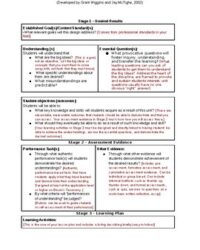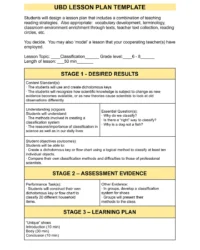For educators, crafting lessons that truly resonate and achieve meaningful learning outcomes can feel like a complex puzzle. We all want to move beyond simply covering content and instead foster deep understanding in our students. This is where a powerful framework known as Understanding by Design, or UBD, comes into play, offering a thoughtful, student-centered approach to curriculum development that begins with the end in mind. It’s a transformative way to think about teaching and learning.
But even with the best intentions, staring at a blank screen or a pristine notebook page can be daunting when it’s time to translate UBD principles into an actual lesson. That’s precisely why having a reliable blank ubd lesson plan template at your fingertips is such a game-changer. It provides the essential structure you need to plan effectively, ensuring every component of your lesson aligns with your ultimate teaching goals.
Why Understanding by Design is a Game-Changer for Educators
Understanding by Design is a curriculum framework that shifts the traditional lesson planning process on its head. Instead of starting with activities or topics, UBD encourages educators to begin with the desired results and then work backward. This “backward design” approach ensures that instruction, learning activities, and assessments are all purposefully aligned with clear learning goals, leading to more coherent and effective teaching.
The beauty of backward design lies in its clarity and purpose. When you know exactly what you want students to understand and be able to do, every instructional decision becomes more intentional. This contrasts sharply with the common pitfall of “activity-based” teaching, where engaging activities might be fun but don’t always lead to deep, lasting understanding. UBD helps teachers avoid this by focusing on enduring understandings and essential questions that drive student inquiry.
UBD is typically broken down into three distinct stages, each vital for comprehensive lesson development. Understanding these stages is key to utilizing any template effectively.
Stage 1: Identify Desired Results
This is where you define what you want students to know, understand, and be able to do by the end of the unit or lesson. It involves pinpointing enduring understandings (big ideas that transcend individual topics), essential questions (open-ended, thought-provoking questions that spark inquiry), and specific knowledge and skills students will acquire.
Stage 2: Determine Acceptable Evidence
Once you know what students should learn, the next step is to figure out how you’ll know they’ve learned it. This stage focuses on assessment. You design performance tasks that require students to demonstrate their understanding and develop rubrics to evaluate their proficiency. It also includes identifying other evidence like quizzes, observations, or dialogues that will show student progress.
Stage 3: Plan Learning Experiences and Instruction
Only after defining desired results and acceptable evidence do you plan the actual teaching and learning activities. This stage involves designing a sequence of lessons that will help students achieve the desired understandings and prepare them for the assessments. Many educators use the W.H.E.R.E.T.O. framework here to ensure comprehensive planning: Where is the unit going? Hook the students. Explore and equip them. Rethink and revise. Evaluate. Tailor to individual needs. Organize for maximum engagement.
Having a structured template for UBD planning doesn’t just make the process easier; it ensures you cover all these crucial bases. It acts as a guide, prompting you to consider each stage thoroughly, which ultimately leads to more robust and impactful lessons.
Finding and Customizing Your Ideal Blank UBD Lesson Plan Template
With the principles of Understanding by Design firmly in mind, the next practical step for many educators is to find a tool that facilitates this planning. A blank ubd lesson plan template serves as that essential framework, offering a ready-made structure where you can plug in your specific curriculum content, learning objectives, and assessment strategies. The great news is that there are many options available online, catering to various grade levels and subject matters, or you can even create your own from scratch based on UBD’s core tenets.
When searching for or developing your ideal template, consider what features will be most beneficial for your planning style. A good template will clearly delineate sections for each of the three UBD stages, providing ample space for you to detail your desired results, evidence of learning, and the instructional plan. It should be intuitive to use, allowing you to focus on the content of your lesson rather than wrestling with the format. Remember, the goal is to streamline your planning, not complicate it, so user-friendliness is key.
Ultimately, a blank UBD lesson plan template is a tool that should empower your teaching, not constrain it. Don’t be afraid to adapt and personalize it to fit your unique classroom context and student needs. Here are some tips for making the most of any template you choose:
- Always start with Stage 1: Identify Desired Results. This backward planning approach is the cornerstone of UBD.
- Feel free to add or expand sections within the template to include details crucial for your planning, such as differentiation strategies, technology integration notes, or specific materials needed.
- Use the template as a living document. It’s perfectly fine to revisit and refine your plan as you gain insights from teaching the unit or observing student progress.
- Collaborate with colleagues. Sharing and discussing how you use a blank UBD lesson plan template can lead to new insights and improved planning techniques for everyone.
Embracing the Understanding by Design framework, especially with the aid of a well-structured template, can transform your approach to teaching. It encourages deep reflection on learning goals and ensures that every educational activity serves a clear purpose, moving beyond mere content delivery to true student understanding.
By investing time in thoughtful UBD planning, educators equip themselves to create lessons that are not only engaging but also profoundly effective, fostering lasting knowledge and skills in their students. This methodical preparation is a testament to dedicated teaching and a commitment to student success.


